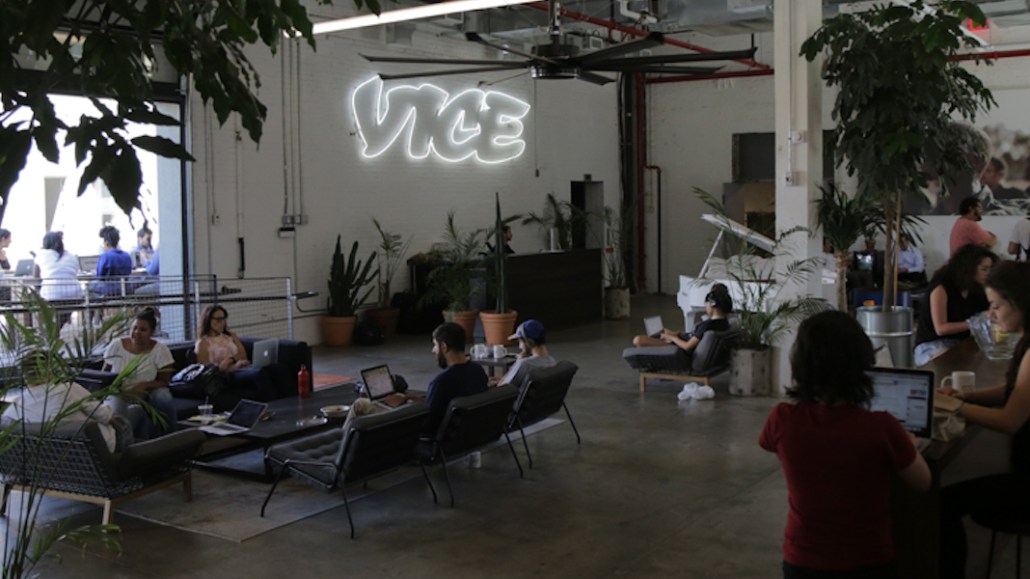Save 50% on a 3-month Digiday+ membership. Ends Dec 5.

Vice Media is the media empire largely built off being an content agency. For years, the Brooklyn media company has worked closely with brands to make them cool, or at least make their brands part of cool content.
Now, Vice wants to prove to advertisers that this kind of branded content is effective while giving them a better understanding of the audience they’re reaching. To do this, Vice has partnered with WPP-owned research giant Kantar on two research-centric initiatives. The first one, called Vice Voices, comes from a partnership with Kantar’s Lightspeed product, which Vice is using to create a panel of 30,000 visitors to Vice’s site that the publisher and its ad partners can use for audience and behavioral research. The second product, through a partnership with Kantar’s market research firm, Millward Brown, allows Vice and its advertising clients to measure how audiences are engaging with branded content and the overall effectiveness of those campaigns.
“We have more demand from clients to execute on brand studies,” said Oliver Laubscher, chief media officer at Vice. “This is our first step in representing branded content in a more accurate way through the help of a third party.”
Branded content and other ad agency-style work is a big part of Vice’s business, but branded content has come under scrutiny as advertisers raise questions about its effectiveness. Laubscher declined to say how much of Vice’s business was from custom content campaigns, though according to a Wall Street Journal report, a majority of the company’s 2016 revenues were expected to come from such work.
Recent Vice branded-content campaigns include “Culture of Kong,” a text and video series produced with Warner Bros. to promote “Kong: Skull Island,” and “15 Years of SB Dunk,” a 20-minute documentary short film produced for Nike.
Vice Voices and the Millward Brown research partnerships are being overseen by a dedicated team of two people, led by Julie Arbit, vp of insight at Vice Media, with plans to add two more. While this duo will oversee the research day to day, it will also pull in staffers from other departments when needed. (Kantar also has a team working out of Vice’s offices to help with the partnership.)
Older publishers, including The New York Times and Condé Nast, already offer advertisers the ability to go deeper with audience and ad impact data. Vice is further along than most of its digital competitors in offering a tool like this, said Noah Mallin, head of social at agency MEC Wavemaker. “They’re not as far along as the platforms, which have been going deeper for a while,” said Mallin. “But what Vice is doing is something a lot of the digital-first community is starting to, which is to get beyond talking about simply delivering content and to a place where they talk about what impact the content has.”
Ad position: web_incontent_pos1
Vice intends for Vice Voices to play a key role as a research and planning tool. It’s also pitched as a way for Vice’s audience to provide feedback on content and interests, and see how other users are responding. The initial plan is to do multiple studies per week using a total panel base of 30,000 users, then double that next year as Vice and Kantar take the product to foreign markets. “It really is a way for us and our clients to get another layer of access to this generation,” Arbit said.
Improving ad effectiveness has been a major priority for Vice. Last year, the site redesigned its site with a focus on getting rid of intrusive ads, which led to people spending twice as long viewing Vice’s ads than before. By investing in its internal tech stack and pushing back against slow vendors, Vice said it was also able to reduce average page-load time by half and average ad-load time by about 80 percent in the past six months.
Advertiser trust and safety has been a key theme of this year’s Digital Content NewFronts, and it was no different for Vice, which announced a partnership with ad analytics company Grapeshot to scan Vice’s online content to ensure ad messages aren’t placed next to content clients don’t want to be associated with.
“We want to measure that better and be more accountable through these research products,” said Laubscher.
Image via Vice
More in Media

Digiday+ Research Subscription Index 2025: Subscription strategies from Bloomberg, The New York Times, Vox and others
Digiday’s third annual Subscription Index examines and measures publishers’ subscription strategies to identify common approaches and key tactics among Bloomberg, The New York Times, Vox and others.

From lawsuits to lobbying: How publishers are fighting AI
We may be closing out 2025, but publishers aren’t retreating from the battle of AI search — some are escalating it, and they expect the fight to stretch deep into 2026.

Media Briefing: Publishers turn to vertical video to compete with creators and grow ad revenue in 2026
Publishers add vertical video feeds to their sites to boost engagement, attract video ad spend and compete with news creators.
Ad position: web_bfu


